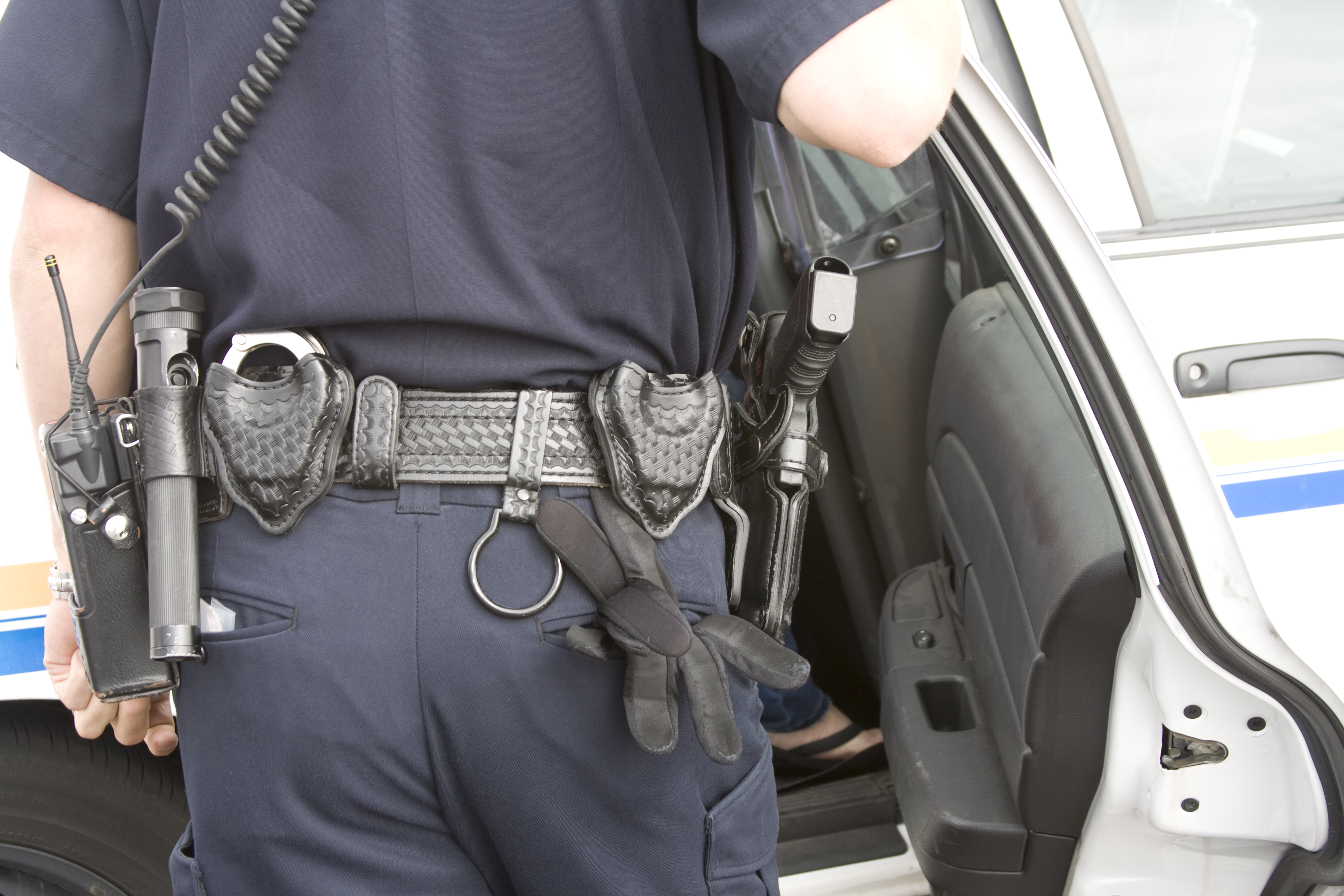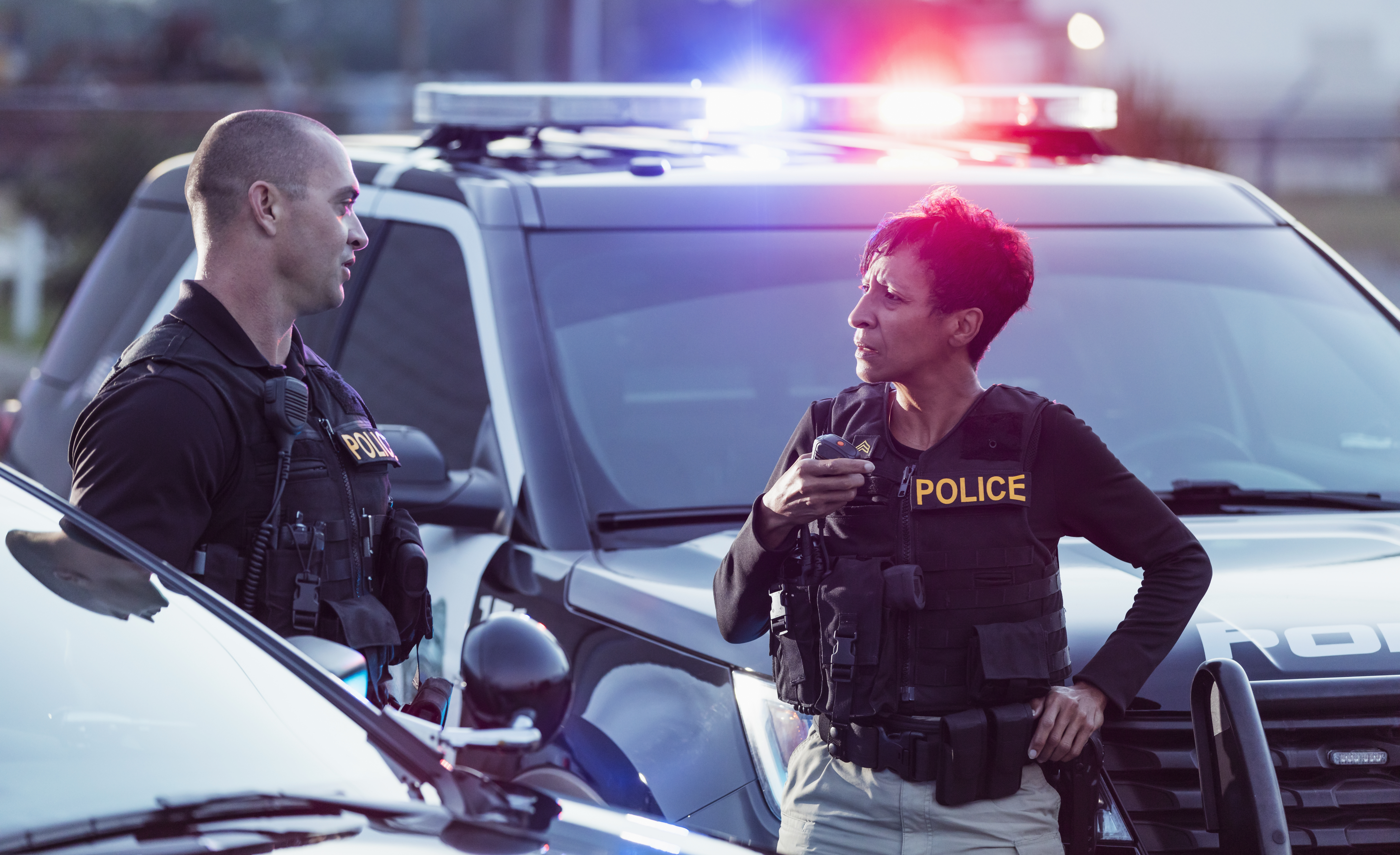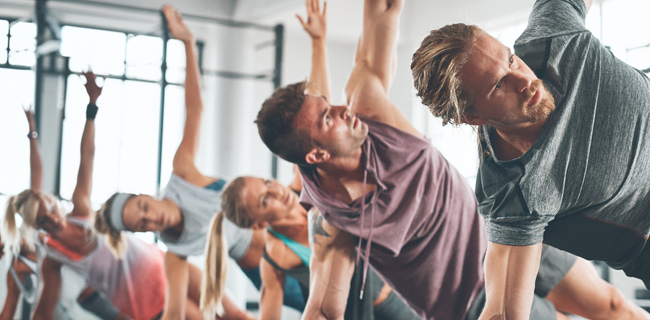Contact Us
To provide feedback on the Community Policing Dispatch, e-mail the editorial board at CPDispatch@usdoj.gov.
To obtain details on COPS Office programs, publications, and resources, contact the COPS Office Response Center at 800-421-6770 or AskCopsRC@usdoj.gov

U.S. Department of Justice
Office of Community Oriented Policing Services
Washington, DC 20530
“You’d see these cops walking a little bowlegged, swaggering around,” said Rosa Brooks, a former Washington (D.C.) Metropolitan Police Department officer in a February 2021 interview with National Public Radio (NPR). “I thought that was related to being arrogant or wanting to be intimidating. But I realized (later) that it's mostly just that you have so much stuff on your belt and vest that you can't walk normally.”
Brooks was commenting on the effect of the heavy burden that today’s law enforcement officers are required to carry. At a minimum, it includes a radio, handcuffs, gun, baton, flashlight, camera, cell phone, and pepper spray.
Tool Weight Impacts Performance and Causes Permanent Injury
 Together, these tools and the duty belt or vest they’re attached to can add 20 pounds or more to the weight officers bear. And in a tactical situation, equipment such as a ballistic shield, assault rifle, flashbangs, helmet, and body armor can increase that amount substantially.
Together, these tools and the duty belt or vest they’re attached to can add 20 pounds or more to the weight officers bear. And in a tactical situation, equipment such as a ballistic shield, assault rifle, flashbangs, helmet, and body armor can increase that amount substantially.
But far worse than the ungainly walk is the toll this tool weight takes on an officer’s body—the musculoskeletal damage—and the negative impact it has on their ability to run, change direction, carry a victim, or deal with a noncompliant offender.
Even when standing still, the heft and bulk of the equipment can reduce an officer’s range of motion and have a negative effect on marksmanship.1
How to optimize safety and performance while reducing the wear and tear on their officers’ bodies has bedeviled law enforcement for many years. One solution is to literally lighten the load with synthetic materials; another is to distribute the weight with a more ergonomic design for belts and vests.
Measure the Carriage System to Fit the Duty and Posture
Though suspenders can make some of the weight easier to bear, a duty belt may still impact the range of motion for bending forward, while also affecting hip position in a car seat.
In a Canadian study2 that evaluated the effects of duty belt and driver seat design on posture and discomfort, officers reported a high prevalence of problems in the lower back from prolonged driving. Though both genders benefitted from improved seat design, male officers benefited more from a reduced belt configuration.
Vests can reduce hip and lower back pain by distributing weight more evenly. Arms can swing more freely, too. Not to mention, vests are increasingly popular amongst law enforcement officers. But, they must be properly measured for sitting, standing, and running. What may feel good when officers try on vests may be uncomfortable or restrict range of motion later, depending on what they are doing. And, this can lead to changes in posture that cause muscle strain. Australian studies of different brands found that even one variation in equipment distribution impacted comfort or movement.3
Fitting the Load to Female Officers
 The weight of the equipment carried by all officers is almost always a higher percentage of a female officer’s body weight than it is of a male officer’s. Moreover, the design of the utility belt can be especially hard for women when they take breaks.
The weight of the equipment carried by all officers is almost always a higher percentage of a female officer’s body weight than it is of a male officer’s. Moreover, the design of the utility belt can be especially hard for women when they take breaks.
In her interview with NPR, Rosa Brooks said, “It’s well known by women police officers that you have to take everything off and put it on again, and just hope a vital call won’t come in while you’re in the ladies’ room. This is one of many small but important reasons that it’s hard to attract women to law enforcement.”
Spatial limitations on belts fitted to women’s waists can also be a problem. In a February 2011 article on Police1, former police officer Betsy Brantner Smith suggests that women prioritize what they attach to a utility belt, possibly carrying some tools, such as the Taser, on the thigh. She also suggests a minimum of four belt keepers to provide a more stable platform for the equipment.4
Another of her recommendations is carrying the belt’s tools toward the front, off the spine and kidneys, and positioning the holster so it sits low enough and off the hip to prevent the permanent nerve damage that plagues many female patrol cops.
Too Big or Too Small is Unsafe
 Tactical vests and body armor can be not only restricting and uncomfortable for a woman but also unsafe. In 2018, the National Institute of Justice (NIJ) stated that the seventh revision to its body armor performance standard, NIJ Standard 0101.07, included testing to ensure that female-designated models provide adequate protection. The statement noted that in discussions, female officers said that body armor issues include improper fit, riding up or shifting out of place, and skin abrasions.
Tactical vests and body armor can be not only restricting and uncomfortable for a woman but also unsafe. In 2018, the National Institute of Justice (NIJ) stated that the seventh revision to its body armor performance standard, NIJ Standard 0101.07, included testing to ensure that female-designated models provide adequate protection. The statement noted that in discussions, female officers said that body armor issues include improper fit, riding up or shifting out of place, and skin abrasions.
Body armor can also (ironically) decrease officer safety. According to Daniel Longhurst, a mechanical engineer who coordinated the effort to revise NIJ standards, “Armor that is too small leaves areas such as the shoulder blade, armpit, sides, and waistline vulnerable; armor that is too big is uncomfortable, rides up, and could restrict access to an officer’s weapon".5
Types and styles of female-designated vests vary, as do ways of fitting them to accommodate the various sizes and shapes needed for female officers. As with carriage systems for any gender, it's best to research brands for a company that produces the best solutions for the department’s staff.
Building the Strength and Endurance that Lighten the Load
 In addition to changes in carriage systems, some agencies are mitigating the negative impact of heavy tools on officers’ bodies through strength and conditioning programs that include resistance and aerobic training. Physical fitness is critical to supporting endurance and agility, and so are a healthy weight and good nutrition. Research indicates that, even when wearing a relatively light load, greater body fat percentage negatively correlates with physical task performance.6
In addition to changes in carriage systems, some agencies are mitigating the negative impact of heavy tools on officers’ bodies through strength and conditioning programs that include resistance and aerobic training. Physical fitness is critical to supporting endurance and agility, and so are a healthy weight and good nutrition. Research indicates that, even when wearing a relatively light load, greater body fat percentage negatively correlates with physical task performance.6
Adequate sleep is equally important. Not only does it increase an officer’s energy but it also enables them to engage in the conditioning programs that increase endurance. Adjustment to patrol shifts have been shown to reduce fatigue in some departments.
A Holistic Approach Combining Equipment and Fitness Training
To provide time to work out as well as time to rest, the Bend (Oregon) Police Department readjusted patrol shifts to consist of three teams covering three shifts, working 11.25-hour days with four days off each week. This schedule provides enough overlap to allow officers on duty to participate in wellness programs without causing gaps in coverage. There is always a full complement of officers on patrol while members of another unit are engaging in fitness activities. Patrol teams also rotate their shifts every two months, which is less disruptive to the natural sleep cycle than more common schedules, reduces sleep deprivation, and allows officers to have access to wellness programs.
The weight that officers must carry for up to 12 hours a day—and the muscle fatigue and injury that often result—are unlikely to change any time soon. But by combining the use of well-designed carriage systems with physical fitness and strength training, law enforcement agencies can not only lighten the burden but also increase officers’ safety and enhance their performance.
Faye C. Elkins
Sr. Technical Writer
COPS Office
Learn More
For additional resources, please visit the COPS Office’s Officer Safety and Wellness page.
References
1 Robin Orr et al., “Focus on Officer Wellness: Police Officer Load Carriage Requirements,” Police Chief 87, no. 4 (2020),https://www.policechiefmagazine.org/focus-on-officer-wellness-police-officer-load-carriage-requirements/.
2 M.W.R. Holmes et al., “The Effects of Police Duty Belt and Seat Design Changes on Lumbar Spine Posture, Driver Contact Pressure, and Discomfort," Ergonomics 56, no. 1 (2013), 126–136, https://doi.org/10.1080/00140139.2012.739206.
3 Ben Schram et al., “Comparing the Effects of Different Body Armor Systems on the Occupational Performance of Police Officers,” International Journal of Environmental Research and Public Health 15, no. 5 (2018), 893, https://doi.org/10.3390/ijerph15050893/.
4Betsy Brantner Smith, “Is Your Duty Belt Designed for Women?” Police1, last modified February 15, 2011, https://www.police1.com/archive/articles/is-your-duty-belt-designed-for-women-6hYQ0tT44hiXLGXq/.
5 Michele Coppola, “Body Armor for Female Cops: What’s Next?” Tech Beat, last modified December 29, 2014, https://www.police1.com/women-officers/articles/body-armor-for-female-cops-whats-next-NumDp8eCPcCVIaAi/.
6Richard Ricciardi, Patricia A. Deuster, and Laura A. Talbot, “Effects of Gender and Body Adiposity on Physiological Responses to Physical Work while Wearing Body Armor,” Military Medicine 172, no.7 (2007), 743–748, https://doi.org/10.7205/MILMED.172.7.743.
Subscribe to Email Updates
To sign up for monthly updates or to access your subscriber preferences, please enter your email address in the Subscribe box.






